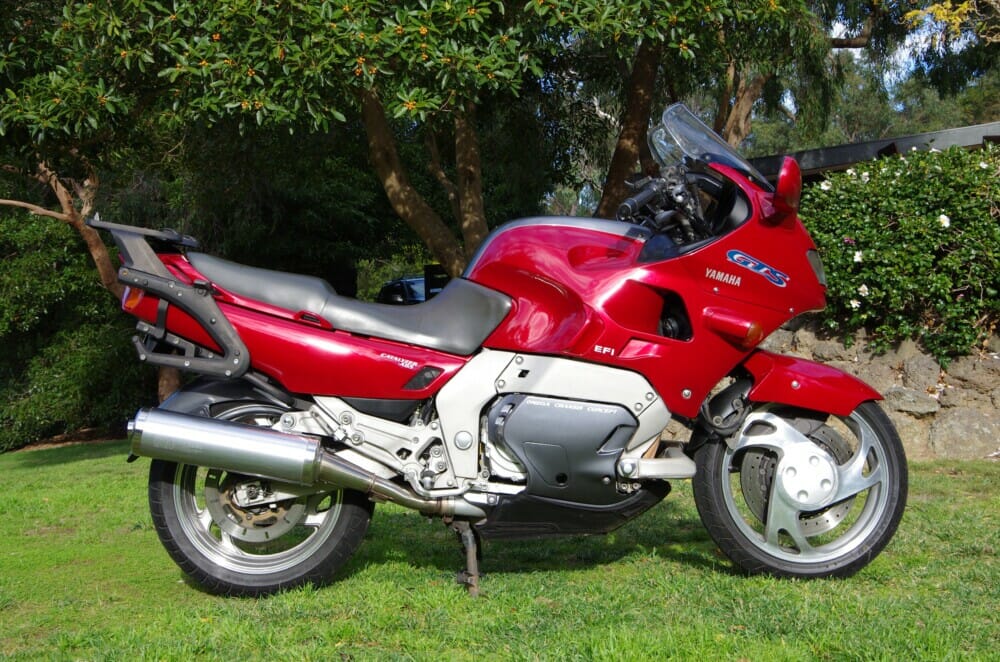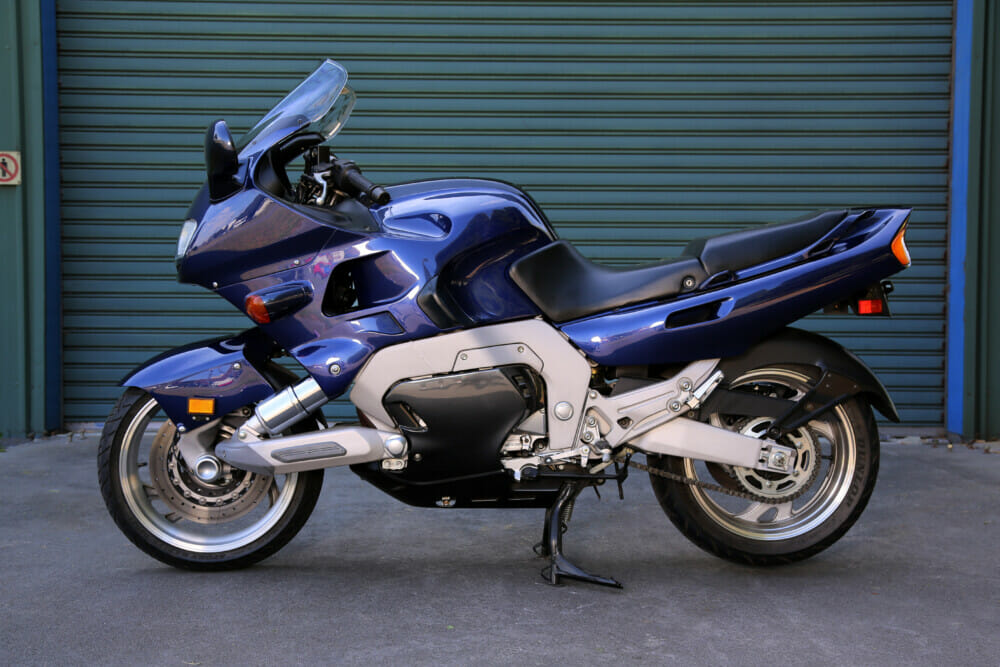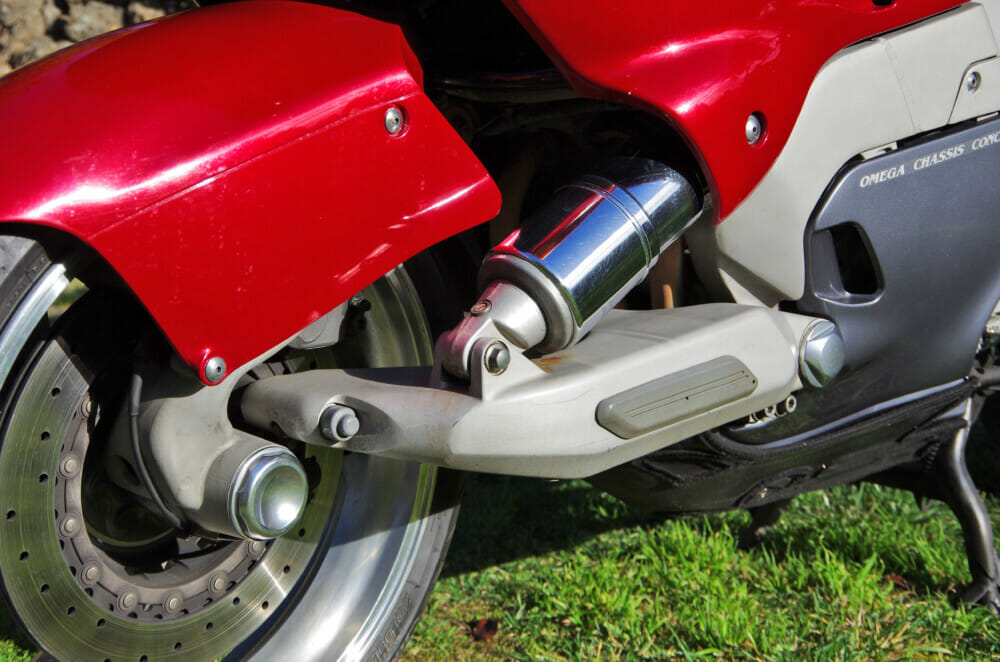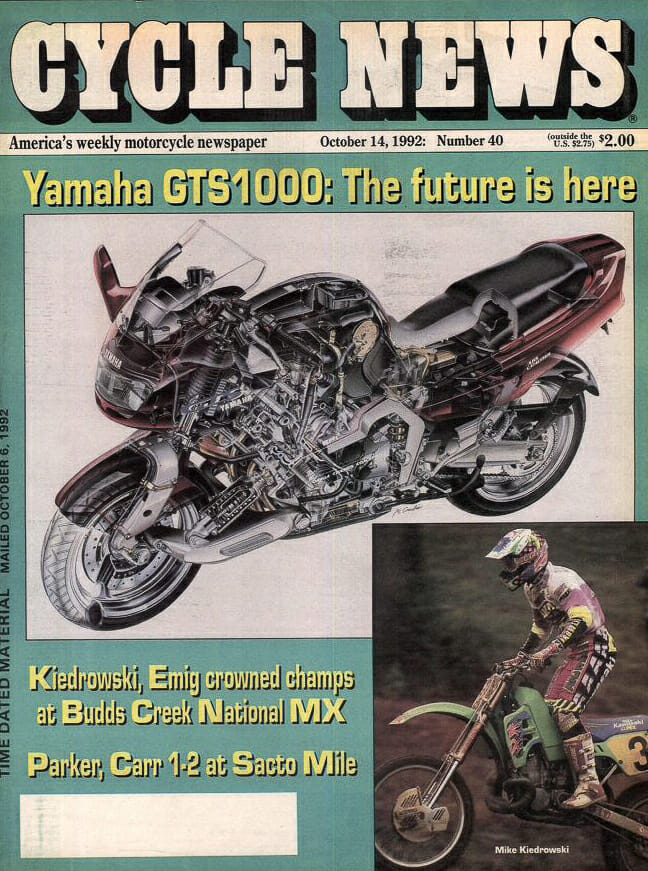| September 11, 2022
Cycle News Archives
COLUMN
The Yamaha GTS1000, 30 Years On
By Jim Scaysbrook
The quirky Yamaha GTS1000 turned many heads in 1992, many billing it as the dawn of a new era in steering and suspension setup. We at Cycle News even said, “The Future is Here.” Perhaps we were wrong on that one.
We throw it over to Jim Scaysbrook, father to our own Road Test Editor, Rennie, and a legend of the Australian motorcycling and in particular, classic industry, to tell the GTS’s short-lived story.
 A cult classic now, the GTS1000 failed to hit the mark when it was released and was only sold for two years in North America.
A cult classic now, the GTS1000 failed to hit the mark when it was released and was only sold for two years in North America.
In that hot bed era of motorcycle development—the 1930s—the twin parameters of performance, namely power and handling, came under equal and increasing scrutiny. In the case of the latter, there was plenty of scope for innovation, given that the standard designs had changed little in several decades. The girder fork, in its various permutations, was still the accepted standard, and had so far resisted innovations such as leading link and even hub-center steering. The coming thing was the fully telescopic fork, popularized by several manufacturers, notably BMW, and copied by many, including Norton.
But “teles” came with numerous built-in restrictions and shortcomings. For a start, the thin diameter front tubes were subject to stresses of all the wrong kinds, particularly under braking, when the weight transfer placed major strain on the sliding surfaces and their ability to continue to slide happily.
However, by the early ’80s, the move was afoot to supplant the thinking that “teles” were the only solution. In the racing world, the French Elf, with its radical front-end, showed that it was quite competitive in 500cc GPs in the hands of British star Ron Haslam, while Bimota pressed their own radical creation, the Tesi, into production, replete with its own spin on the hub-steer front end and an astronomical price tag to suit. None of these efforts, although commendable, really made inroads into the world of volume production, but meanwhile, in Germany and Japan, other concepts were being studied closely.
 The GTS1000 looks striking in Yamaha blue.
The GTS1000 looks striking in Yamaha blue.
BMW had never been shy in coming forward with unique thinking. After all, they had produced the first hydraulically damped telescopic fork in 1935 and had stuck with the Earles-design of swingarm front suspension (aka leading links) for decades. In 1981, BMW adopted the Nicol Link system, developed by Brit Hugh Nicol, which was marked as the Telelever—the idea being to isolate steering from suspension, which is what had been the aim all along. It also isolated braking from suspension, thereby eliminating one of the main drawbacks of the telescopic system. The system also allowed the steering geometry to remain constant, reduced the tendency for the front-end to dive under braking, and because the front wheel was no longer heading back towards the engine whenever the forks were compressed, designers were free (or freer) to experiment with weight distribution and the placement of the mass of the engine.
Interestingly, at about the same time as BMW was embracing the British Nicol concept, Yamaha was similarly engrossed in studying a system developed by an American company called RADD—Rationally Advanced Design and Development—under the engineer James Parker.
 By the time the GTS1000 had made it to production, designer James Parker noted the Japanese had made the upper arm of the front suspension too short, meaning that rake and trail increased with steering angle and produced heavy steering at slow speeds.
By the time the GTS1000 had made it to production, designer James Parker noted the Japanese had made the upper arm of the front suspension too short, meaning that rake and trail increased with steering angle and produced heavy steering at slow speeds.
In 1987, Parker modified a Yamaha FZ750 to create what he called the MC2, which incorporated his design of front-end using a car-type upright to hold the front wheel and brake calipers, pivoting by means of upper and lower suspension arms, or pull-rods. It was actually the steering process, rather than the suspension side, that had puzzled engineers for ages, and Parker’s solution was via what he termed a “steering shaft”—in effect a telescopic unit itself—which incorporated special bearings to allow the shaft to move with the suspension. Parker had studied the Elf bikes, and particularly why they had not achieved the success he felt was deserved. He felt the problem was “bump steer,” whereby during the suspension’s travel, changes in the angles of the linkages produce unwanted input to the front wheel, and hence, the steering. Parker’s “steering shaft,” which he patented at considerable expense, was the solution. The original Honda 600-engined development machine demonstrated Parker’s ideas but failed to convince Honda to take up the scheme. Next stop was Yamaha, who showed a little more interest, and the prototype was test ridden at Willow Springs Raceway in Southern California by no less a figure than Wayne Rainey, who gave it the thumbs up.
This was enough to swing Yamaha to support Parker’s project, providing an FZ750 as well as the input of their California design studio GKDI, which produced the bodywork for what became the MC2. Late in 1987, that machine appeared at the Milan Show, and a little further down the track, Yamaha entered into an agreement with Parker to access his patents for the production of an all-new sports touring machine, based around the successful FZR1000 powerplant.
This was to evolve into the GTS1000, but along the way, the svelte MC2 concept added considerable bulk, and although Parker went to Japan several times to view the progress, he was not permitted to have any engineering input. He said later that he only ever saw the bike fully clothed in its extensive bodywork, and only had the opportunity to measure the front-end after the GTS1000 had reached the production stage. At that point, he realized that his design had been compromised and that the upper arm of the front suspension was too short, meaning that rake and trail increased with steering angle, producing heavy steering at slow speeds.
The GTS1000 duly appeared, slightly flawed front-end and all, while Parker moved on, producing a new Suzuki GSX-powered model which further refined his theories. By 1993, the GTS1000 was on sale. The GTS was marketed as incorporating the Yamaha Omega Chassis Concept—Omega chosen because the frame as such resembled the Greek letter Ω.
Because the loads generated from the front suspension were now transferred (via the swingarm) back to the front of the chassis rather than up to the steering head as on a telescopic-fork bike, the frame could be totally redesigned. That frame consisted of horseshoe-shaped cast aluminum sections welded together, plus bolted up lower sections which were removable to allow the engine unit to be dropped out. Suspension at both ends was by swingarm—the rear mounted in the conventional way through the main frame behind the gearbox and the front, single-sided arm pivoting from the forward casting below the line of the crankshaft. To permit the required steering lock, the front swingarm was curved, with a rather massive single shock absorber running from the arm back to the frame near the cylinder head.
So that’s the suspension side. As previously noted, the steering was a completely separate exercise. From the upright holding the front wheel on the left side, a steering arm with ball-joints at each end connected to a junction box, from which the telescopic arm (the “steering shaft” from Parker’s original design) ran to the steering head, which was controlled, as normal, by handlebars connected to a stem. The huge 330mm front brake sported an opposed six-piston caliper, with Yamaha’s ABS, which itself had been developed on the FJ1200.
But while the radical front end was the visual signature of the GTS, it was by no means the only innovative feature of this quite daring motorcycle. Although the engine was derived from the five-valve-per-cylinder FZR1000, it was detuned (and limited to 100 horsepower worldwide) with lower compression and milder cam timing, with Yamaha’s own electronic fuel injection. This used sensors for throttle position, air density, engine revolutions, coolant temperature and the oxygen content in the exhaust system, with continuous adjustment to maintain optimum mixture and fuel economy.
Inside the exhaust system lurked a three-way catalytic converter, which was claimed to reduce harmful exhaust emissions by 60 percent.
In terms of fit-out, the GTS was fairly plush, with an electronic fuel gauge, clock, anti-theft ignition, a choice of two screens and a generous pillion seat. Genuine luggage was also available—at a price. One styling feature that received a less than enthusiastic reception was the fuel tank, or rather, what looked like the fuel tank. With the engine block and head cantered forward by almost 45 degrees, the fuel injection system intakes sat vertically, capped by a voluminous airbox. This relegated the fuel tank itself to a space above the gearbox, with a plastic shroud encasing the whole lot.
For a motorcycle which must have absorbed a considerable budget to develop, the GTS1000 enjoyed a very brief existence; on sale for just two years in North America, although it remained available in other markets a bit longer. The reasons for this are many and varied, but one is that Yamaha tried to market the machine as both a sports bike and a tourer.
The riding position, with the rider’s weight forward, was a bit too sporty for long distance touring, but the engine, detuned from the FZR’s angry 130 horsepower to 100, ran out of breath well below the 10,500 red line. The milder spec was also intended to boost low and midrange grunt but needed around 6000 rpm on the clock before it really got moving.
There was also criticism of the front brake, with claims that the ABS was over-sensitive, and that at low speeds the bike felt heavy and unresponsive. And then there was the price of $12,999, a considerable sum back in 1993.
 Perhaps we got a little carried away with our headline on that one.
Perhaps we got a little carried away with our headline on that one.
Any or all of these factors may have been responsible for sluggish sales in the target market of the USA, but buyer reluctance has always been influenced by fashion, and convincing riders that the long-loved telescopic front fork was dead was never achieved in the case of the GTS1000. In the eyes of Joe Public, the GTS was unusual looking, had none of the exotic design flair that graced the other quirky front-end model, the Bimota Tesi, and was expensive (although it was less than one third of the Bimota’s price ticket here in the States). It was also prodigiously thirsty, British testers complaining of a fuel range of just 120 miles and consumption of around 33 mpg.
Today, the GTS1000 is a rare bird, but it always was. Spares are not exactly plentiful, but there is an Owners Club with nearly 400 members who assist with locating parts, and rightly regard the model as a cult classic. CN